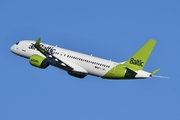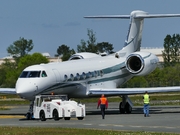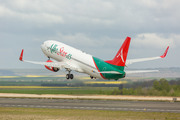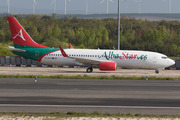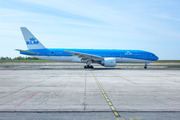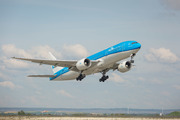Dépêches
Fitch Rates Metropolitan Washington Airports Authority's Ser 2009C Revs 'AA'; Outlook Stable
Dépèche transmise le 2 juin 2009 par Business Wire
NEW YORK--(BUSINESS WIRE)--Fitch Ratings assigns an 'AA' underlying rating to Metropolitan Washington Airports Authority's (the authority) $310 million airport system revenue bonds series 2009C. In addition, Fitch expects to assign a rating, based upon the support of a direct-pay letter of credit (LOC) to be provided by Bank of America, to the authority's $136 million airport system revenue variable-rate bonds, series 2009 nearer to closing. In addition, Fitch affirms the 'AA' long-term rating on the authority's approximately $5 billion outstanding revenue bonds. The Rating Outlook is Stable.
The proceeds of both series of bonds will be used to refinance all of the authority's $432 million flexible Passenger Facility Notes (PFCs), and the bonds will have a final maturity of 2039. The series 2009C bonds are secured by a pledge of authority net revenues. Authority net revenues include revenues generated at both Washington Dulles International Airport (Dulles) and Reagan National Airport (National), plus transfers, if any, from the general purpose fund to the revenue fund, following payment of operations and maintenance (O&M) expenses. The bonds have a final maturity of 2039. The Rating Outlook is Stable.
The 'AA' rating reflects the authority's well-established role as an international gateway airport, strengthened by the continued international service additions at Dulles, the sustained strong and stable financial operations of the airports, the strong and growing air trade area, and the demonstrated ability of management to guide a complex capital program. Offsetting the moderate airline concentration risk is the strong origination and destination (O&D) profile of traffic at both Dulles (62%) and National (81%), and favorable demographic trends within the affluent service area. The rating also reflects the authority's competitive position and complementary service offerings of both Dulles and National and conservative forecasting practices that demonstrate sound coverage of debt service through the capital program. Primary credit concerns include the moderate single-carrier concentration risk at each of the authority airports, the higher cost profile to support the capital construction program (CCP), and the resultant rising costs passed onto the airlines, and risk posed by a debt portfolio with approximately 19.8% variable-rate debt.
Currently, the authority's outstanding debt consists of 80.2% fixed-rate bonds and 19.8% variable-rate debt. Although Fitch recognizes that the authority has entered into forward starting swap agreements to hedge future borrowing costs, overall uncertainty related to external liquidity renewal remains. Should a large portion of the authority's variable-rate bonds be put into bank bond mode and market access is limited, the authority may be faced with higher interest rates and a tighter amortization profile. This alternative scenario would place significant pressure on the authority's finances and some adjustments would need to be made to both capital and operating expenditures, while efforts to maximize revenues are executed in order to meet the rate covenant. If such a scenario would materialize and failed to be mitigated in a timely manner, downward rating action would be likely. Yet, Fitch notes the positive actions the authority has taken to reduce its swap exposure as well as ensure adequate debt service reserves. Recently the authority terminated three swap agreements and completed the conversion to all cash funded debt service reserves from those funded with surety bonds.
Management has demonstrated the ability to mitigate declining traffic trends by reducing its capital construction program (CCP) as well as through implementing cost containment strategies. The authority has significantly reduced its CCP program from $7.06 billion to $4.84 billion due to the announced capacity reductions nationwide by U.S. carriers and the capacity reductions of 6.5% at Dulles, which covers the period from 2001-2016. Of this figure, $3.5 billion has already been spent, and the authority expects to issue an additional $378 million through 2009-2012 in support of the program. Major elements of the program include a new runway and an automated people mover at Dulles which is set to open in the near-term; however, similar to management actions in response to depressed travel levels post 9/11, plans for a new Tier 2 concourse and a consolidated rental car facility were deferred in July 2008 from the overall plan. In 2008, signatory airline costs per enplaned passenger (CPE) were $12.31 at Dulles and $10.95 at National. Based on the 2009 Budget, the authority's CPE will dramatically rise in 2009, with a system-wide increase to $17.72 from $12.13, largely reflecting the near completion of the authority's large capital plan being absorbed into the rate base. Though well above historic norms, Fitch notes that the signatory airlines have already approved the MII provisions related to these projects. Furthermore, the authority expects to partially mitigate the large increase in CPE by executing 2009 budgetary controls. To date, a 10% reduction in overtime, a freeze on operating costs, and a hold on staffing needs have been implemented to maintain financial flexibility and manage the cost base that the airlines are exposed to. Notwithstanding, it is Fitch's view that the authority may be hard pressed to offset further enplanement declines with operations and maintenance reductions.
First quarter 2009 financial results show positive trends despite enplanement stagnation, with operating revenues slightly higher than first quarter 2008 and operating expenses on budget. However, under review of various stress scenarios that included substantial enplanement declines in the near term and a protracted recovery period, debt service remains above 1.35 times (x) but projected CPEs are materially higher than currently anticipated, potentially making the airports' cost structure uncompetitive and inconsistent with the current rating level.
Historical financial performance has been stable. The authority has consistently generated healthy financial results, with an operating ratio near 40% on an annual basis. Debt service coverage has consistently been above the rate covenant of 1.25x, with the authority generating coverage of 1.57x for fiscal 2008 (Dec. 31 year-end) above 1.6x since 2004. In 2009 the authority expects debt service coverage to be 1.62x, with a decline to slightly under 1.4x in 2011 given the growth in debt service obligations, which is below the original forecast of 1.6x through 2016 (the forecast period). The decline in debt service coverage is potential credit risk. However, consistent with past practice, Fitch expects the authority to continue to manage operations within a more constrained financial profile and implement adjustments to maintain credit metrics commensurate with the current rating.
Passenger activity has been stable at Dulles after rebounding strongly in 2007 from a significant decline in activity following the January 2006 demise of Independence Air (Independence), which stimulated demand in the market through its aggressive pricing strategy. The initiation of service by Independence, the former Atlantic Coast Airways and operator of United Express service at Dulles, in 2004 spurred a 60% increase in enplanements from 2003-2005. With Independence leaving the market in 2006, enplanements declined by 15% for the year. However, the level of demand identified by Independence resulted in other carriers initiating or adding service, including United Airlines (United), JetBlue Airways (JetBlue) and Southwest Airlines (Southwest). As a result, Dulles experienced an 8% increase in enplanements in 2007 over 2006; however, domestic enplanements were down by 6% in 2008 from 2007, which was partially mitigated by a 12% increase in international travel. Enplanement declines are mainly attributable to softening of the U.S. economy and the trend of airlines to cut low yielding flights in order to restore profitability. For 2009, the authority predicts overall enplanements will be down by 4.7% from 2008.
United and its affiliates remain the largest carrier at Dulles, representing 64% of enplanements. The carrier has acted to increase international service at the airport, exploiting its dominant position in the nation's capital with adding service to Beijing, China; Rome, Italy; and Rio de Janeiro, Brazil in 2007. In 2008, despite significant turmoil in the industry, United continued to expand with new service to Dubai, United Arab Emirates in October 2008 followed by new service to Moscow, Russia in 2009. Foreign carriers have also increased service to Dulles, with Iberia Airlines initiating service to Madrid, Spain; Aer Lingus serving Dublin, Ireland; Qatar Airways serving Doha, Qatar; and Copa Airlines serving Panama. New carrier schedules available for summer 2009 indicate continued international growth, with the addition of new service to Munich, Germany and Geneva, Switzerland and increased frequencies to six other major European cities. Through April 2009, enplanements are down by 6% from the same timeframe in 2008.
National has also experienced a significant gain in enplanements, with 2006 traffic volume up 30% from 2003 as carriers used larger aircraft, experienced higher load factors, and were able to add a limited number of flights. Enplanement activity through 2008 has been relatively stable at National, as airport activity is restricted by federally imposed flight limitations. Total enplanements in 2008 were down by 3.4% from the prior year. Through April 2009, enplanements declined by 4% from the same timeframe in 2008. Going forward, the authority expects a decrease of 1.4% in 2009 and relatively flat enplanement growth post 2010. US Airways and its affiliates remains the largest carrier at National, with 41% of the market in 2007. While the concentration levels of United and US Airways present some credit concern, the level of concentration is less pronounced when viewed on an overall basis, as United represented 39% of total system enplanements in 2008 while US Airways accounted for 19%.
Fitch's rating definitions and the terms of use of such ratings are available on the agency's public site, www.fitchratings.com. Published ratings, criteria and methodologies are available from this site, at all times. Fitch's code of conduct, confidentiality, conflicts of interest, affiliate firewall, compliance and other relevant policies and procedures are also available from the 'Code of Conduct' section of this site.
- 24/04Ibis Styles London Heathrow : l'hôtel géré par un passionné d'aviation pour les passionnés d'aviation (photos + vidéos)
- 23/04 SkyUp renouvelle son partenariat avec Wizz Air
- 23/04 Play : résultats de mars 2024
- 23/04 Les garde-côtes japonais commande trois Airbus H225 supplémentaires
- 23/04 Vueling et Make-A-Wish France signent un partenariat
- 23/04 TUI annonce ses destinations au départ de Deauville pour l'été 2024.
- 23/04 Twin Jet renforce son programme de vols sur la ligne Toulouse/Rennes
- 23/04 Norse Atlantic Airways : résultats du mois de mars 2024
- 23/04 Volotea renforce son offre entre Lille et le Maroc
- 22/04 Finnair a dévoilé son programme de vol pour les saisons hiver 2024 et été 2025
- 22/04 Qatar Airways annonce le lancement de vols à destination de Kinshasa
- 22/04 Vietnam Airlines et CAE prolongent leur accord
- 22/04 Mermoz Academy de Tours commande des Tecnam P-Mentor
- 22/04 Transavia France reçoit son 2e Airbus A320neo
- 20/04 Friedrichshafen 2024 : Blackwing présente un nouveau modèle de son BW650RG
- 20/04 Friedrichshafen 2024 : JMB Aircraft présente son Phoenix
- 19/04 Friedrichshafen 2024 : le projet "Fly To The North"
- 19/04 Friedrichshafen 2024 : Aura Aero présente pour la première fois ses trois appareils
- 19/04 Friedrichshafen 2024 : Duc Hélices présente son hélice Tiger-3
- 19/04 Friedrichshafen 2024 : Splash-in Aviation expose son Pétrel X


